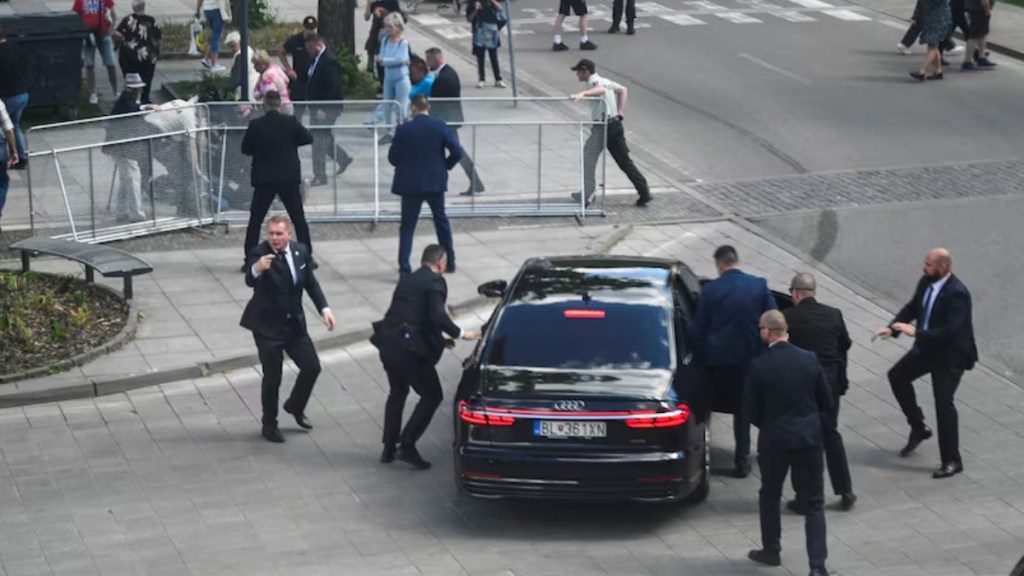Slovakia’s Prime Minister Robert Fico faced an assassination attempt on May 15 in Handlova, Slovakia, where he was shot and injured. Reports indicate he underwent surgery after being rushed to a hospital. The incident occurred after Fico attended a meeting at the House of Culture in Handlova, where he was reportedly shot in the stomach. Police swiftly detained the suspect and secured the area.
The assailant, identified as Juraj Cintula, a 71-year-old poet, attempted to assassinate PM Fico. Cintula, reportedly a former employee of a private security firm and a poet, was apprehended after the incident. In an official statement on Fico’s Facebook page, it was revealed that he sustained multiple gunshot wounds and was in critical condition. He was airlifted to Banská Bystrica for urgent surgery due to the lengthy journey to Bratislava.
Fico, a seasoned politician who served as prime minister four times, has been criticised for allegedly favouring Kremlin-aligned policies in Slovakia’s foreign affairs. World leaders, including Russian President Vladimir Putin and US President Joe Biden, condemned the attack, labelling it as monstrous and horrific. Prime Minister Narendra Modi also expressed shock at the news on May 16.
Robert Fico’s early life
Fico, born in 1964 in what was then Czechoslovakia, began his journey into politics after graduating from law school in 1986. His involvement started with the Communist Party just before the 1989 Velvet Revolution, a pivotal moment that marked the end of communist rule and the beginning of democratic reforms.
During the 1990s, Fico served as a representative for the Slovak Republic before the European Court of Human Rights and the European Commission of Human Rights. His initial entry into Slovakia’s Parliament came in 1992, representing the Party of the Democratic Left.
Despite his ambitions, Fico faced setbacks when he was overlooked for a ministerial position by the Democratic Left Party (SDL), the political successor of the Communist Party, in 1998. This disappointment led him to resign abruptly the following year to establish his own party, the Smer-Social Democrats (Smer-SD), where he has remained a prominent figure ever since.
Slovakia Prime Minister’s rise, strategies and setbacks
In 2006, Robert Fico’s departure from the SDL proved fruitful as his party, Smer-SD, achieved a resounding victory in Parliament. This triumph swiftly elevated Fico to the prime ministerial position, merely two years after Slovakia’s entry into the European Union (EU). By forming an alliance with the far-right Slovak National Party (SNS), which shared his staunch anti-refugee stance and populist leanings, Fico cemented his authority as a leftist leader.
Capitalising on the backdrop of the 2008 global financial crisis, Fico strategically bolstered his public support by rejecting austerity measures. Slovakia’s integration into the eurozone in 2009 marked the zenith of Fico’s initial four-year tenure as prime minister. However, electoral outcomes in 2010 relegated him to the opposition benches after his attempts to forge coalitions faltered, despite his party’s electoral successes.
Controversial legacy
During the European refugee influx of 2015, Fico took a tough stance on migration, firmly opposing the creation of a separate Muslim community in Slovakia and strongly criticising the EU’s refugee quota program.
In 2018, amidst controversy surrounding the tragic murder of Slovakian investigative journalist Jan Kuciak and his fiancée, Fico and his government resigned. Kuciak’s investigations had implicated high-ranking Slovak politicians in tax-related wrongdoing.
Over time, the experienced leader gained notoriety for his verbal assaults on journalists and was charged with criminal offences in 2022, including the alleged establishment of a criminal organisation and abuse of power.

